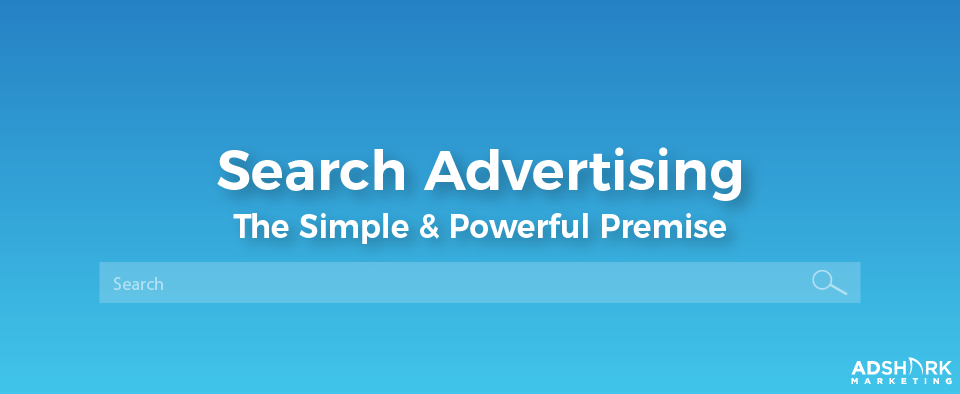Search Advertising: The Simple & Powerful Premise
When is the best time for your business to present itself to potential customers? Is it on the radio while people mindlessly drive down the street? Is it on television while they’re watching their favorite show? Or is it when they’re outside and see a billboard for your business?I would argue that disruptive advertising is not the best place to focus your business’ message.
The best time to show your message is when your potential customers are looking for it.
Television, radio, and billboard are all fine branding and awareness plays, but they are also disruptive to the user. How many people hate commercials? Whole businesses have been built to avoid radio advertising. People driving down the highway see dozens of billboards, so how much time do you think they have to soak in your message? Even if they do, and if they want to remember it, chances are by the time they get to their destination, they’ve forgotten.
A few decades ago, search advertising meant placing an ad in the phone book. In the 21st century, people are using search engines to find services and products and do research. But from a business standpoint, not all search queries are the same.
Measuring & targeting intent
Think of Google as the old phone book but more nuanced, more segmented, and with more features.
How much would a business pay be shown to a user who searches for “best trucks“? Most likely not much. The user is in the research part of the sales funnel, which is at the very top. Capturing that click isn’t going to be worth much at the moment. They are likely to visit several different websites in search of the best truck, and yours is just one of many.
The beauty of search advertising is that you can segment your ads to queries with buying intent.
Now how much would a business pay be shown to a user who searches for “Used Ford F150 for under $20,000 in Minneapolis, MN”?
Significantly more than the previous query. The second search is deeper in the sales funnel than the previous one, and that holds more value. The research appears to have been completed by the user to determine which vehicle make and model he or she wants, and a qualification based on price is also present, indicating pre-approval by a bank or auto dealership. That is a search query that can lead to a sale.
By using tight keyword targeting, (either phrase, exact, or broad match modified), targeting intent has never been easier. Targeting intent when a user searches for products or services is a relatively new capability for businesses. It goes back only 15 to years when Google launched AdWords in 2000.
Direct attribution to measure ROI
Google has built a multi-billion-dollar business on the simple premise of search advertising. How do you build a billion-dollar advertising platform? You need to be able to track sales, leads, and signups to measure ROI.
There’s an old saying in advertising that goes:

Attribution in search advertising isn’t difficult to track for either direct sales or leads. A Google forwarding number is used to track phone calls, and conversion pixels (bits of code) are used to track those who clicked an ad and then bought, even if that sale is a few days after the initial click.
The metrics your business finds most important will determine the attribution model. It’s rare that I encounter a situation where we can’t track all conversions, and this usually has to do with an error in a client’s website’s architecture.
Why I work In search advertising
I ventured into the search advertising niche of the marketing world because the basic premise made sense to me. What do I do when I’m looking for information? I search for it on Google. When am I most receptive to advertising? When I’m looking for those services.
It’s such a simple concept yet one of the most powerful advertising tools available today. TV commercials may be good for overall branding and to blast a message to a large segment of the population, but they’re also disruptive to the end user. How many people do you know who say they love television commercials? I’m guessing not many.
I work in advertising and I get some joy out of seeing well-done commercials with clever taglines, but frequently I fast-forward through them with my DVR. Most people have the same experience.
While search advertising isn’t disruptive to the end user, it only works if you have a way to funnel that website traffic into sales. This is where I spend a lot of my time. How do you take website traffic and turn that into revenue for a business? Many times there are changes that need to be made to a website to achieve that goal, but once it’s achieved, it’s almost instantly scaleable.
The hard part is getting the fundamentals in place and doing it right so that the campaign converts website traffic.
The beauty of the internet is that once you have a campaign that’s achieved a conversion-rate goal or a cost-per-acquisition goal, it’s easily expanded. You can increase budgets to show up for more of the searches you’ve targeted. Your campaign that has been optimized for conversions can then reach a larger percentage of potential customers.
In conclusion
The cost of inbound marketing has gone up over the last few years as more companies discover the power of targeting intent, but it’s still relatively inexpensive by advertising standards. The most effective advertising will always be non-disruptive to a consumer who is searching for your message.
Need help with your internet marketing strategy? Contact us for a free customized consultation so you do internet marketing right the first time.
Ready To Grow?
Let's Talk!


